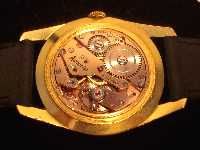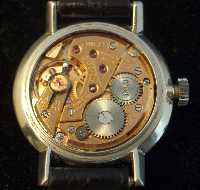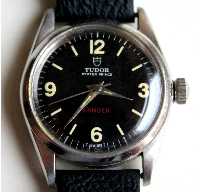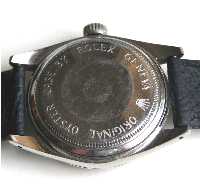Vulcain
I am a big fan of many watch brands, but the one that I consistently seek out on eBay is a not very well known company called Vulcain. Established in 1858, they made high quality Swiss watches all through the early 20th century. They disappeared into obscurity for a while but re-emerged in 2001 with a new backer I believe. While some of their new watches are very nice (see here), I love their vintage watches the most which are often a bargain.
 My first encounter with Vulcain was when I saw this watch on eBay. I had to have it, it is still probably my favourite looking watch that I own and a joy to wear. The amazing jump hour dials spin instead of having an hour and minute hand. The hour hand snaps neatly into place on the hour every hour. It has a lovely satin finish dial and is a good size watch given its age.
My first encounter with Vulcain was when I saw this watch on eBay. I had to have it, it is still probably my favourite looking watch that I own and a joy to wear. The amazing jump hour dials spin instead of having an hour and minute hand. The hour hand snaps neatly into place on the hour every hour. It has a lovely satin finish dial and is a good size watch given its age.

I also managed to pick up this Vulcain chronograph for a bargain price. I've still got to find a strap to do it justice, but I love the complicated dial with its telemeter and tachmeter in red and blue. It is in absolute mint condition for its age, certainly a very smart watch.

I also love this Vulcain Meteor, which is a good solid watch to wear day to day. It has a very elegant dial and reminds me a bit of classic Omegas, very clean and simple
 My first encounter with Vulcain was when I saw this watch on eBay. I had to have it, it is still probably my favourite looking watch that I own and a joy to wear. The amazing jump hour dials spin instead of having an hour and minute hand. The hour hand snaps neatly into place on the hour every hour. It has a lovely satin finish dial and is a good size watch given its age.
My first encounter with Vulcain was when I saw this watch on eBay. I had to have it, it is still probably my favourite looking watch that I own and a joy to wear. The amazing jump hour dials spin instead of having an hour and minute hand. The hour hand snaps neatly into place on the hour every hour. It has a lovely satin finish dial and is a good size watch given its age.
I also managed to pick up this Vulcain chronograph for a bargain price. I've still got to find a strap to do it justice, but I love the complicated dial with its telemeter and tachmeter in red and blue. It is in absolute mint condition for its age, certainly a very smart watch.

I also love this Vulcain Meteor, which is a good solid watch to wear day to day. It has a very elegant dial and reminds me a bit of classic Omegas, very clean and simple






